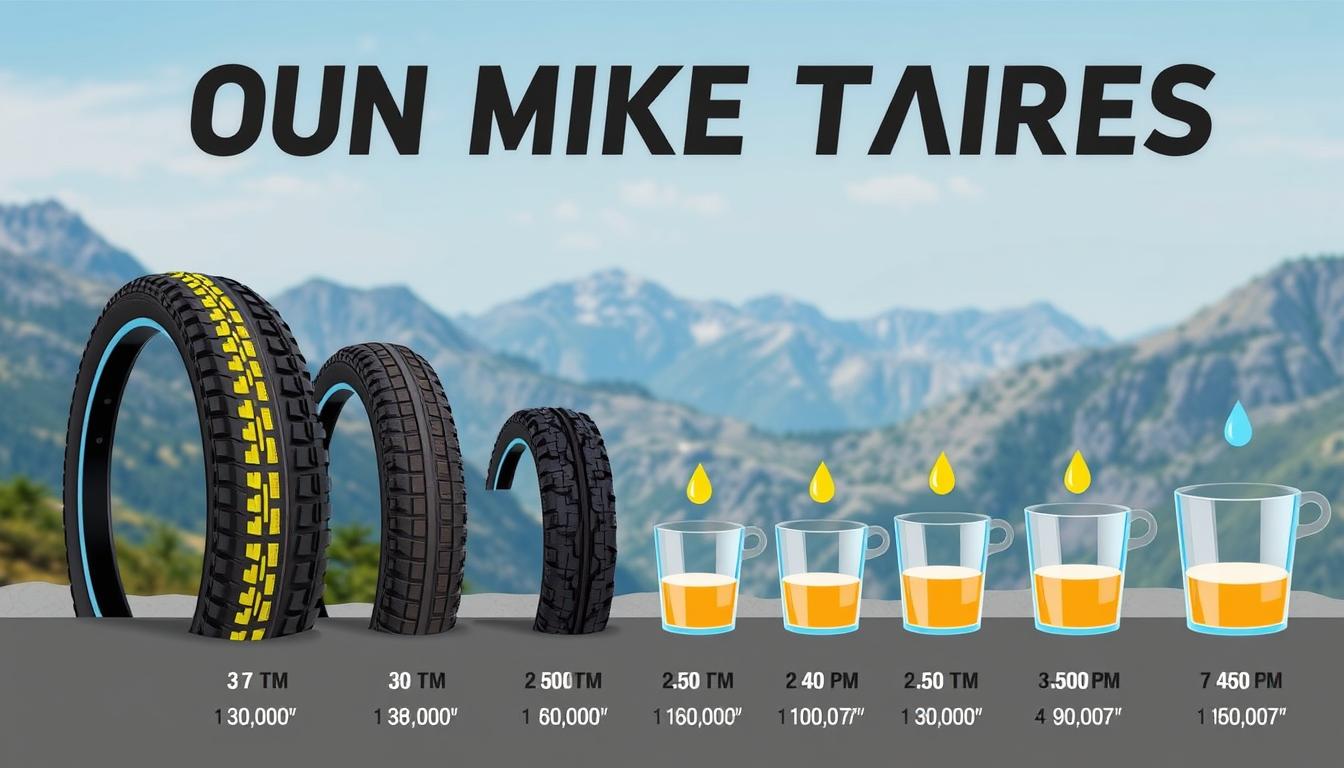Using the right amount of tire sealant is key for your mountain bike’s performance. The right amount prevents punctures and ensures a smooth ride. To find out how much to use, consider your tire size and type.
A good rule of thumb is to use 75-90ml for 27.5-inch tires and 75-95ml for 29-inch tires. Knowing the best amount for your tires is crucial for the best ride.
The right sealant makes a big difference in your ride. It reduces rolling resistance, increases comfort, and improves traction. To get these benefits, follow a guide for the right sealant amount for your tire size.
By doing this, you’ll enjoy a smooth ride and avoid punctures. Remember, the right sealant is key for tubeless tires’ performance.
Key Takeaways
- Using the right amount of tire sealant is crucial for maximizing tire performance and preventing punctures.
- The correct amount of sealant depends on the size and type of your tires.
- A general guideline for mountain bike tire sealant quantity guide is to use between 75-90ml for 27.5-inch tires and 75-95ml for 29-inch tires.
- Understanding the best tubeless tire sealant amount for your specific tire size is vital for optimal performance.
- Using the right amount of tire sealant can help reduce rolling resistance, increase comfort, and provide better traction.
- Following a mountain bike tire sealant quantity guide can help minimize the risk of punctures and ensure a smooth ride.
Understanding Tire Sealant Basics for Mountain Bikes
Mountain biking needs a good grasp of tire sealant basics for a safe ride. The proper mtb tire sealant dosage is key to avoid punctures and keep the bike running well. For ideal sealant volume for tubeless mtb tires, use about four or five ounces for new gravel or mountain bike tires.
The recommended tire sealant amount for mountain biking changes with tire type and riding conditions. For example, a road tire might need just two ounces at first. Also, bike tires are thin and porous, so sealant evaporates and dries out. This means you should add more sealant every two to three months.
To keep the tubeless setup working, take the tire off the rim yearly. Scrape out dried sealant and start fresh. Knowing the basics of tire sealant and using the proper mtb tire sealant dosage makes mountain biking safer and more fun.
How Much Tire Sealant to Use For MTB: Standard Guidelines
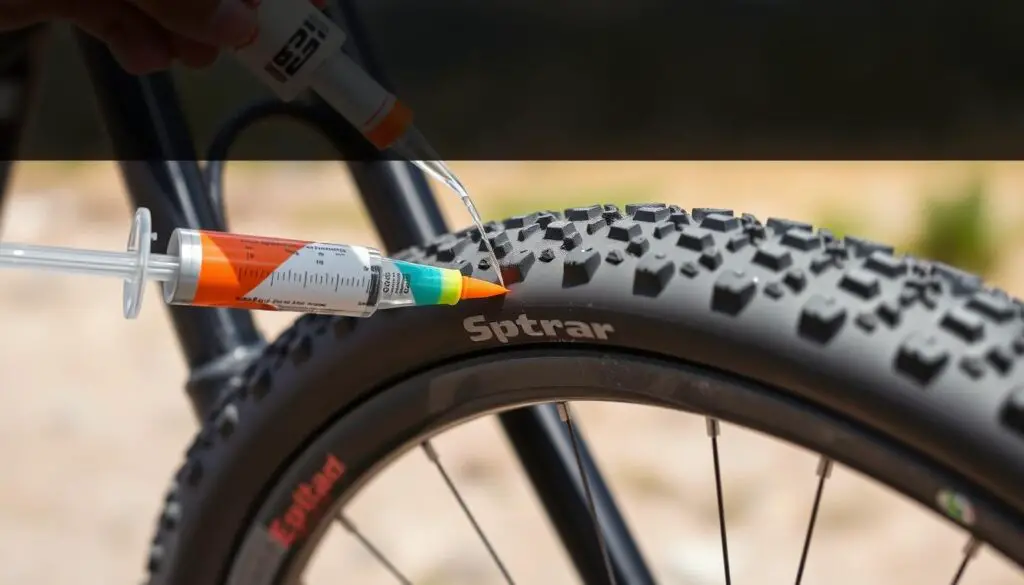
Figuring out how much tire sealant to use mtb involves several factors. The size and width of your tire, along with your riding style, play a big role. A mountain bike tire sealant quantity guide can be a great starting point.
Here’s a simple guide for different tire sizes:
- 26″ & 27″ MTB tires: 60-75ML (4-5 scoops)
- 29″ MTB tires: 105-140ML (7 scoops or whole pouch)
- Downhill MTB tires: 120-140ML (8 scoops or whole pouch)
It’s crucial to match the correct tire sealant measurement for mtb to your tire size and type.
Getting the sealant amount right is key for your bike’s performance. Too little, and you might not get enough protection. Too much can weigh your bike down and affect its handling. By following a mountain bike tire sealant quantity guide and using the right amount, you ensure a safe and fun ride.
Don’t forget to check and top up your sealant every 6 months. Use a high-quality sealant that fits your riding style. With the right sealant and regular care, your tires will last longer and your rides will be smoother and puncture-free.
| Tire Size | Recommended Sealant Amount |
|---|---|
| 26″ & 27″ MTB | 60-75ML (4-5 scoops) |
| 29″ MTB | 105-140ML (7 scoops or whole pouch) |
| Downhill MTB | 120-140ML (8 scoops or whole pouch) |
Factors Affecting Sealant Volume Requirements
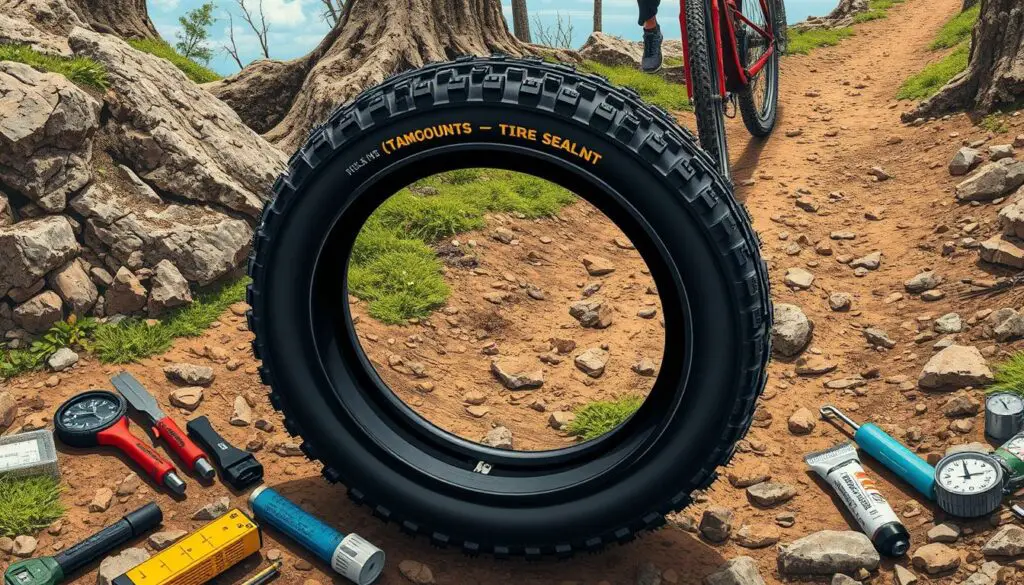
When it comes to optimizing tire sealant quantity for mountain bike, several factors come into play. The size and width of the tire, riding environment, and climate all impact the amount of sealant required. For instance, a larger tire will need more sealant than a smaller one. Riding in harsh environments, such as rocky or thorny trails, may require more sealant to ensure the tire is properly protected.
To maximizing tubeless tire sealant for mtb, it’s essential to consider the specific conditions you’ll be riding in. For example, if you’re riding in a hot and dry climate, you may need to refill the sealant more frequently. On the other hand, if you’re riding in a cool and wet climate, you may be able to go longer between refills. Following mtb tire sealant dosage tips can help you get the most out of your sealant and ensure your tires are properly protected.
Here are some key factors to consider when determining the right amount of sealant for your mountain bike tires:
- Tire size and width: Larger tires require more sealant than smaller ones.
- Riding environment: Harsh environments, such as rocky or thorny trails, may require more sealant.
- Climate: Hot and dry climates may require more frequent refills, while cool and wet climates may allow for longer intervals between refills.
| Tire Type | Recommended Sealant Volume |
|---|---|
| XC 29er | 3-4 ounces (89-118ml) |
| Road and Cyclocross | 2 ounces (60ml) |
| Mountain Bike (MTB) | 80-120 ml |
Calculating Sealant Amounts by Tire Size
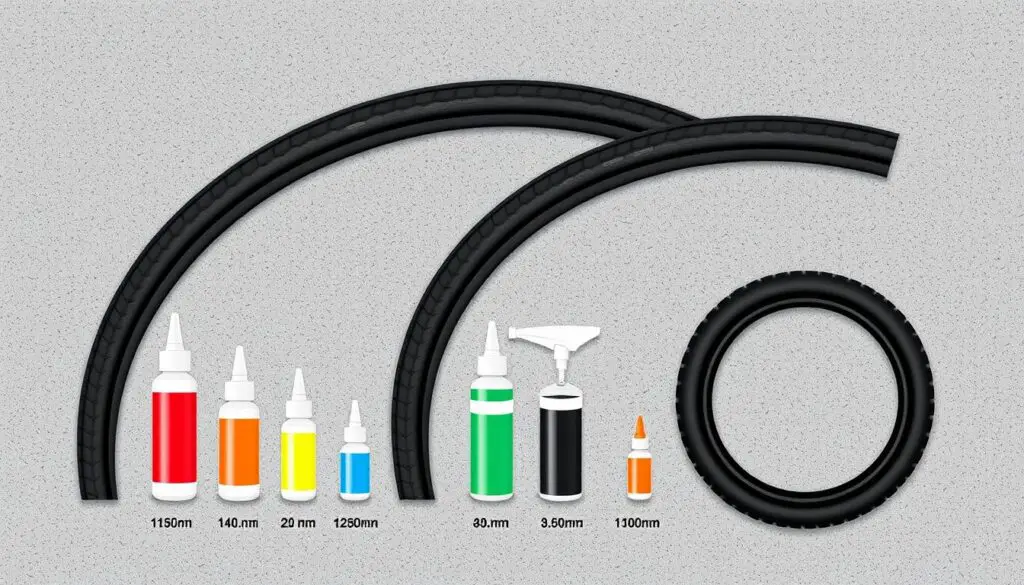
To find the right amount of sealant for your mountain bike, knowing the tire size is key. Each tire size needs a different amount of sealant for the best performance. The amount you should use is often listed by the sealant brand.
NoTubes says to use 60 mL for a 700×40 mm gravel tire and 105 mL for a 29×2.3″ mountain bike tire. Silca recommends 90-120 mL for a gravel tire. These numbers can seem confusing, but a guide can help you figure out the right amount.
A mountain bike tire sealant quantity guide helps you find the right amount for your tire size. Here’s a rough guide:
- 700×25 mm: 35 mL
- 29×2.3″: 90-105 mL
- 26×4.6″: up to 200 mL
Remember, different brands have different suggestions. Some, like Effetto Mariposa, offer online guides. The iCaffelatex app can also help you find the right amount based on your tire and wheel.
In short, knowing the right sealant amount for your tire size is important. A guide can help you find the best amount for your bike. Always check the brand’s recommendations and consider your tire and wheel details for the best results.
| Tire Size | Sealant Amount (mL) |
|---|---|
| 700×25 mm | 35 |
| 29×2.3″ | 90-105 |
| 26×4.6″ | up to 200 |
Common Mistakes When Adding Tire Sealant
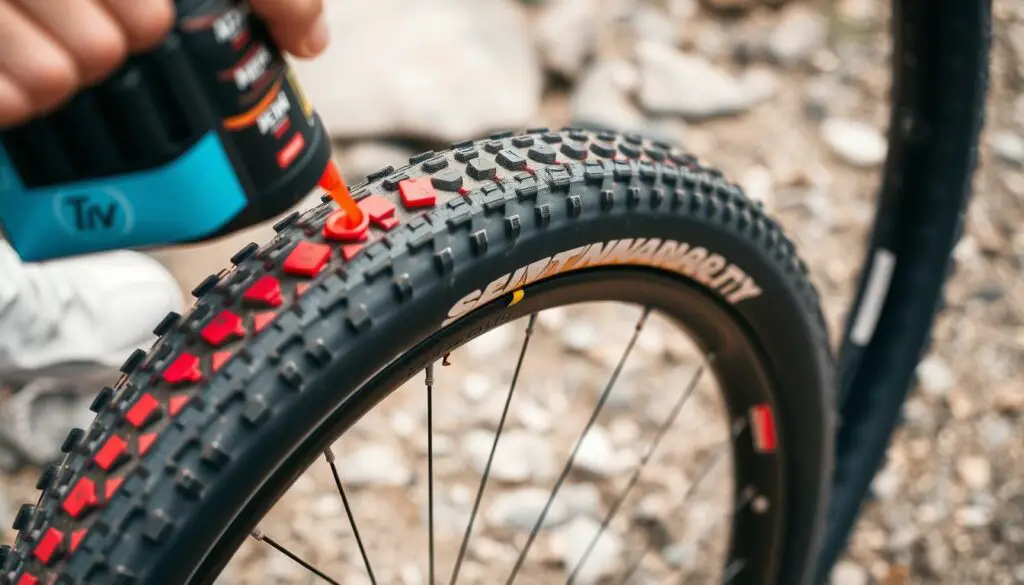
Many cyclists make mistakes when adding tire sealant. This can lead to poor performance and more punctures. It’s important to use the right amount of sealant for your tires and riding conditions.
One big mistake is adding too much or too little sealant. Too much can make your tire slow, while too little doesn’t protect well. Always follow the recommended amount for your bike type. For example, mountain bikes need 80-120 ml per tire, and road bikes need 60-80 ml.
Using the wrong application method can also cause problems. Always follow the manufacturer’s instructions. Regular checks every couple of months help ensure the sealant is working right. By avoiding these mistakes, you can have a safer and more fun ride.
Overfilling Issues
Too much sealant can leak out, making a mess and reducing performance. It also raises the risk of clogging the valve stem and other parts.
Underfilling Problems
Not enough sealant leaves your tire open to damage. Finding the right amount is key to keeping your tire safe and running well.
Special Considerations for Different MTB Disciplines
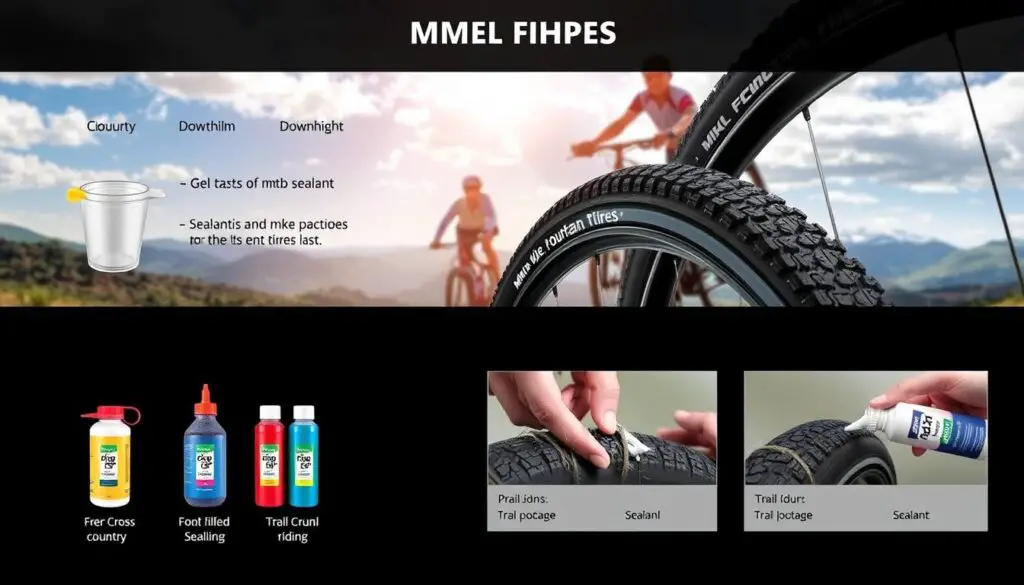
When it comes to optimizing tire sealant quantity for mountain bike, different MTB disciplines have unique needs. The right amount of sealant depends on the discipline’s demands. For example, cross-country riding needs less sealant because of the smoother trails. Downhill and enduro riding, on the other hand, require more sealant for the rougher trails.
To maximizing tubeless tire sealant for mtb, consider your discipline’s specific needs. Here are some tips for different MTB disciplines:
- Cross-country: Less sealant is required due to the smoother terrain.
- Downhill: More sealant is needed to handle the rougher and more challenging trails.
- Enduro: A balance between cross-country and downhill sealant amounts is necessary.
For mtb tire sealant dosage tips, always follow the manufacturer’s advice. Adjust the amount based on your riding conditions. By doing this, you can ensure the best performance and safety on the trails.
| Discipline | Sealant Amount | Terrain |
|---|---|---|
| Cross-country | Less | Smoother |
| Downhill | More | Rougher |
| Enduro | Balance | Mixed |
Seasonal Adjustments for Sealant Quantities
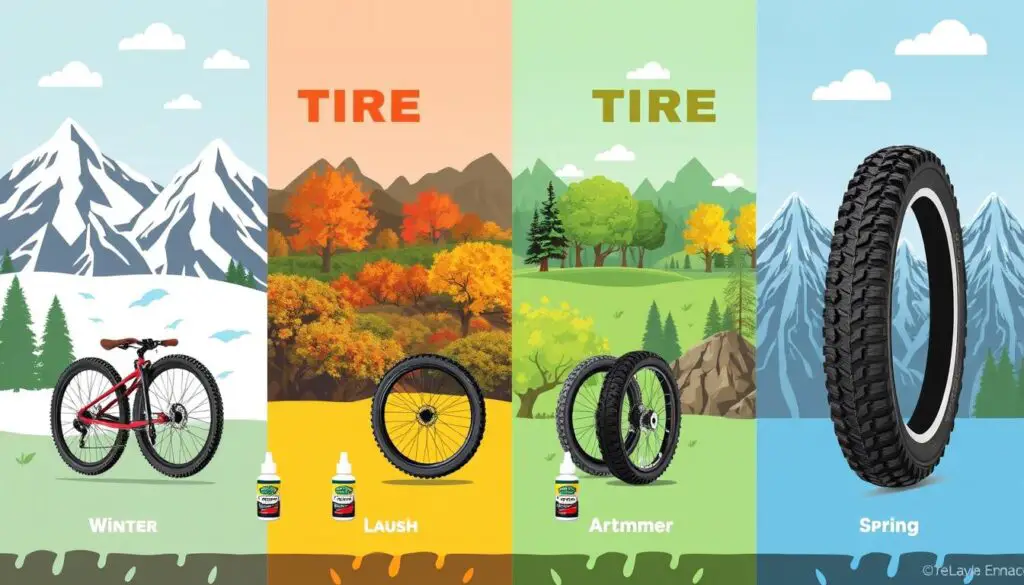
When figuring out how much tire sealant to use on a mountain bike, think about the season. The right amount of sealant changes with the time of year and where you ride.
In summer, use 4-6 fl oz for smaller tires like 26 x 4.25” or 27.5 x 3.0”. For bigger tires, like 26 x 4.8” or 27.5 x 3.8”, add 5-7 fl oz. For winter, increase to 6-8 fl oz to handle cold and wet conditions.
| Tire Size | Summer Sealant Amount | Winter Sealant Amount |
|---|---|---|
| 26 x 4.25” | 4-6 fl oz | 6-8 fl oz |
| 27.5 x 3.0” | 4-6 fl oz | 6-8 fl oz |
| 29 x 2.3-2.5” | 5-7 fl oz | 7-9 fl oz |
By using these guidelines, you can keep your tires sealed and ready for any ride. This helps you stay safe and enjoy your mountain biking.
Signs You Need to Add More Sealant
It’s important to check the sealant level in your tubeless mtb tires often. This helps keep them running smoothly and prevents flats. The right amount of sealant depends on the tire size and type. A good starting point is 80-120 ml for mtb tires.
Look out for signs like a drop in tire pressure or sealant drying out. You might also see more flats. If your bike handles differently or grips less, it’s time to add more sealant. The right amount can change based on where you ride and the weather.
Think about the tire size, where you ride, and the weather when choosing sealant. Hot weather can dry out sealant faster, so you might need more. Cooler weather might let it last longer. By knowing these factors and following the right dosage, you can keep your tires in top shape.
Visual Indicators
- Decrease in tire pressure
- Visible signs of sealant drying out
- Increase in punctures
Performance Warning Signs
- Decrease in tire traction
- Noticeable difference in handling
Watch for these signs and adjust the sealant as needed. Always use the recommended amount for your bike and adjust based on your riding conditions.
Professional Tips for Sealant Application
When it comes to optimizing tire sealant quantity for mountain bike, following professional tips is key. It’s important to understand the right way to apply sealant. This means following step-by-step guides for a successful installation. For example, maximizing tubeless tire sealant for mtb depends on tire size, where you ride, and the weather.
To get the best results, keep these mtb tire sealant dosage tips in mind:
- Refill sealant every 4-8 months, depending on climate
- Use 2 ounces of sealant for a sealant refresh, while 4 ounces may be necessary for a new tire
- Choose the correct width rim for your tire size
Setting up tubeless tires right involves a few steps. First, tape the rim with tubeless rim tape. Then, install valves securely and mount the tire correctly. After that, add sealant following the guidelines. You’ll also need tools like a valve core remover, sealant injector, and a high-volume floor pump or air compressor for a successful setup.
By following these tips and guidelines, you can ensure a successful sealant installation. This way, you can enjoy the benefits of tubeless tires. These include running lower PSI and reducing the chance of getting a flat tire.
Maintaining Optimal Sealant Levels Over Time
To keep your mountain bike tires in top shape, it’s key to have the right sealant amount. The best tubeless tire sealant amount changes based on tire size, where you ride, and the weather. Mountain bikes usually need 80-120 ml of sealant because of the rough trails and sharp objects.
A mountain bike tire sealant quantity guide can show you the perfect sealant amount for your tires. It’s important to check the sealant often, more so in hot weather where it might need topping up every 2-3 months. In cooler areas, sealant can last 4-6 months before needing a refill.
Here are some tips for keeping your sealant at the right level:
- Check sealant levels every 2-3 months, or more often if you ride in tough conditions.
- Use a sealant injector or valve core remover to add sealant as needed.
- Think about making your own sealant for a cheaper and longer-lasting fix.
By sticking to these tips and using the correct how much tire sealant to use mtb, you can avoid flats, cut down on maintenance, and make your mountain bike run better.
| Tire Type | Sealant Amount | Check Interval |
|---|---|---|
| Mountain Bike | 80-120 ml | 2-3 months |
| Road Bike | 60-80 ml | 4-6 months |
| Gravel Bike | 80-120 ml | 2-3 months |
Conclusion: Maximizing Your MTB Tire Sealant Performance
Understanding the right amount of proper mtb tire sealant dosage is key. Larger tires need more sealant because they have more surface area. For big mountain bike tires, start with 60 ml (2 ounces) per tire. Smaller road bike tires might need 30-40 ml (1-1.5 ounces).
Rider weight and tire type matter too. Heavier riders might need more sealant for better coverage. Tires with thin sidewalls might also need more sealant for extra protection. Always check the manufacturer’s guidelines, but you might need to try different amounts to find what works best for you.
By considering these factors, you can find the ideal sealant volume for tubeless mtb tires. This will help you get the most out of your ride. Tubeless tires can run at lower pressures, giving you better grip and a smoother ride. Whether you’re on hard trails or loose ones, finding the right sealant balance is crucial for a great ride.

I am Ryan Ford, a mountain biking enthusiast who loves to explore the outdoors. I also like to go on adventures with friends and anything else that involves being outside. I love my bike because it gets me out of the house and gives me an opportunity to enjoy nature.

